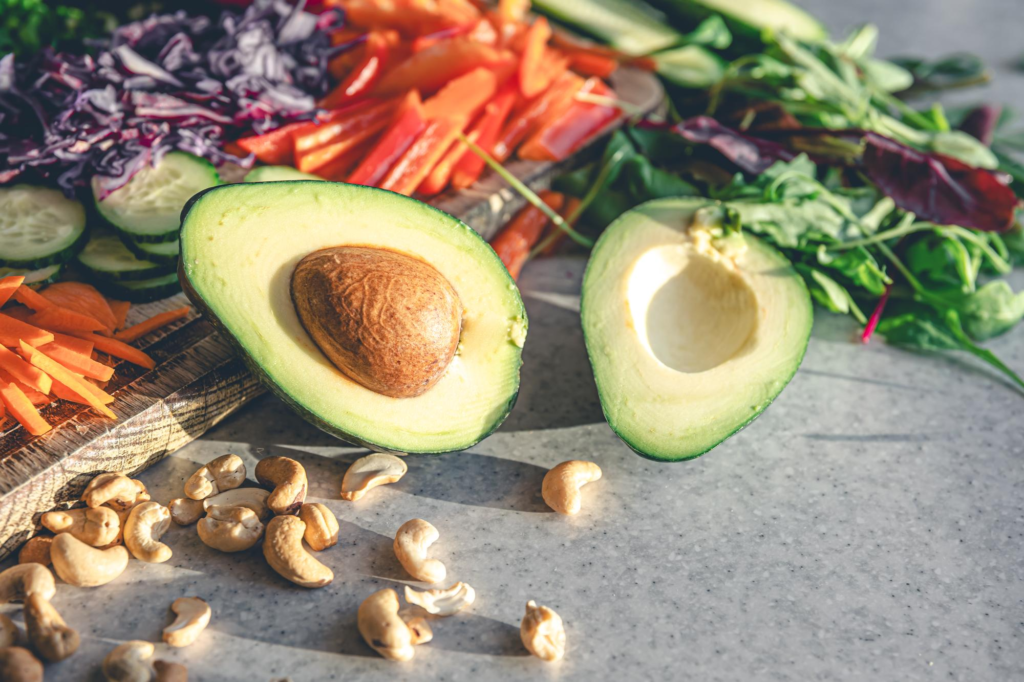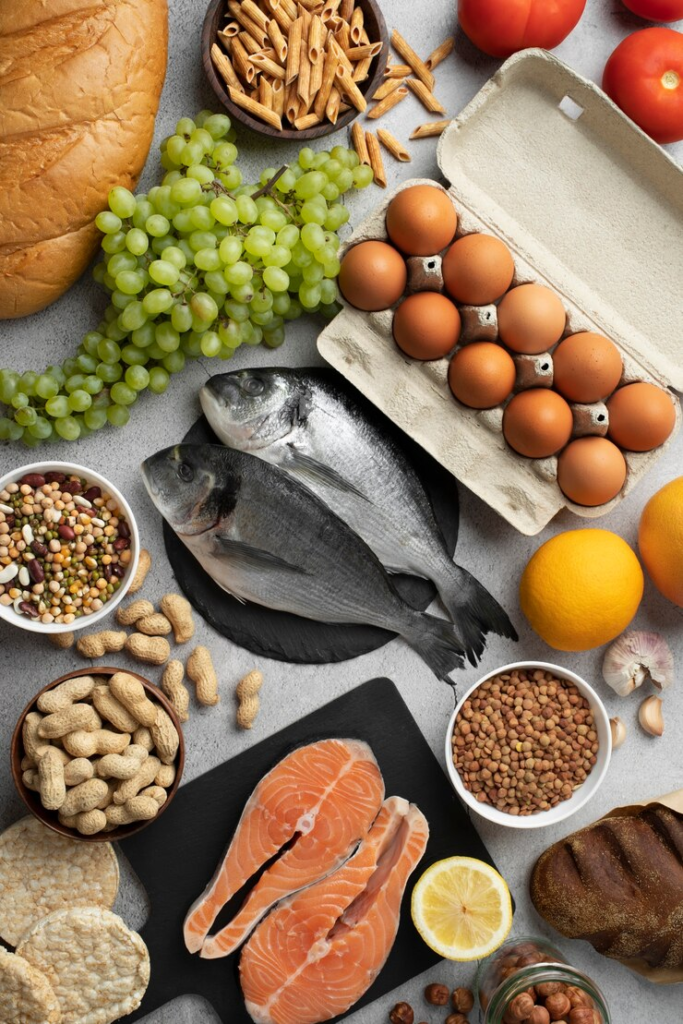Your cart is currently empty!

Skin is often seen as a reflection of inner health. While topical creams and skincare routines can help, true radiance begins far beneath the surface. What we eat shapes how our skin looks, feels, and ages. Nutrition plays a crucial role in maintaining skin clarity, elasticity, hydration, and resilience. From the vitamins that combat free radicals to the fats that support cellular structure, the path to radiant skin often begins in the kitchen. Let’s look at the nutritional strategies that support a naturally luminous complexion.
1. Hydration: The Foundation of a Healthy Glow
Before diving into specific nutrients, hydration deserves the spotlight. Water helps flush toxins, regulate temperature, and maintain the skin’s moisture barrier. Dehydrated skin often looks dull, feels tight, and is more prone to fine lines.

While drinking enough water is essential, hydration comes from water-rich foods like cucumbers, oranges, berries, and leafy greens. Herbal teas and broths can also contribute. Staying hydrated keeps skin plump and supple from the inside out.
2. Healthy Fats: Building Blocks for Soft, Supple Skin
Fats are often misunderstood, but the right kinds are essential for healthy skin. The lipid barrier that keeps moisture and irritation out of the skin is maintained by omega-3 and omega-6 fatty acids. They also reduce inflammation, which can aggravate conditions like acne, eczema, and redness.
Foods to include:
Fatty fish like salmon and sardines
Flaxseeds and chia seeds
Walnuts
Avocados
Olive oil

These fats help reinforce the skin’s structure and can noticeably improve smoothness and elasticity.
3. Antioxidants: Defenders Against Premature Aging
Pollution, UV light, and stress can produce free radicals, which are unstable chemicals that can harm skin cells and hasten aging. Antioxidants neutralize these molecules, protecting collagen and promoting repair.
Key antioxidants include:
Vitamin C in oranges, strawberries, bell peppers, and broccoli is crucial for collagen synthesis.
Vitamin E in almonds, sunflower seeds, and spinach helps protect skin from oxidative damage.
Selenium in Brazil nuts and eggs works with antioxidants to maintain skin integrity.
A wide variety of these beneficial compounds are guaranteed when you include a variety of colored fruits and vegetables.
5. Zinc: The Skin’s Repairman
Zinc is vital in skin healing, inflammation regulation, and immune defense. It’s essential for acne-prone or sensitive skin as it helps control oil production and repair damaged tissue.
Zinc-rich foods include:
Pumpkin seeds
Chickpeas
Beef and poultry
Cashews
Quinoa

Even mild zinc deficiency can lead to breakouts, delayed wound healing, or irritated skin.
6. Collagen-Supporting Nutrients: Firmness from the Inside
Collagen is the body’s most abundant protein and the skin’s main structural element. Our bodies naturally manufacture less collagen as we age, which results in sagging and wrinkles. This process can be slowed down by promoting collagen through diet. Essential nutrients for collagen synthesis:
Vitamin C – Necessary for forming and stabilizing collagen strands.
Glycine and proline: Found in bone broth, eggs, and poultry.
Copper – A trace mineral that supports enzyme activity in collagen formation, found in nuts, seeds, and shellfish.

While collagen supplements are popular, getting these building blocks from whole foods remains a sound nutritional strategy.
7. Polyphenols: Nature’s Skin Enhancers
Polyphenols are plant compounds with powerful anti-inflammatory and antioxidant effects. They may protect against sun damage, improve circulation, and support skin clarity.
Notable sources include:
Green tea (rich in catechins)
Berries (especially blueberries and blackberries)
Dark chocolate (70% or higher cocoa content)
Red grapes and pomegranates
Regular consumption of polyphenol-rich foods has been linked to more even skin tone and improved resilience against environmental stressors.
8. Gut Health: Clear Skin Starts in the Digestive Tract
There’s growing evidence of the gut-skin axis a relationship between digestive health and skin appearance. An unbalanced bacteria in the gut could be a factor in skin sensitivity, acne, or inflammation.
Prebiotic and probiotic foods help maintain gut balance:
Prebiotics: Garlic, onions, leeks, bananas, oats
Probiotics: Yogurt, kefir, sauerkraut, miso
Supporting digestion with fiber and fermented foods can improve skin clarity and texture, especially for those prone to acne or eczema.
9. Sugar and Skin: The Glow-Stealer
Refined sugar contributes to glycation, where sugar molecules bind to collagen and elastin proteins, making them stiff and prone to breakdown. This leads to wrinkles, sagging, and dullness.
High-sugar diets may also trigger insulin spikes, increasing sebum production and inflammation, key players in acne.
To protect skin:
Limit sugary beverages and desserts.
Choose whole fruits over fruit juices.

Balance carbs with protein and fat to stabilize blood sugar.
Reducing sugar intake doesn’t just help your waistline; it’s a direct investment in your skin’s future.

10. B Vitamins: Vital for Skin Tone and Energy
The B-vitamin family supports everything from cell metabolism to red blood cell formation, which affects skin tone and vitality.
Key players include:
Biotin (B7) – Crucial for skin cell growth; found in eggs, almonds, and sweet potatoes
Niacin (B3) – Helps improve skin hydration and may reduce inflammation; found in turkey, brown rice, and mushrooms.
Riboflavin (B2) – Assists in tissue repair and oxygen delivery; found in dairy, spinach, and almonds.
A lack of B vitamins can show dullness, cracking, or irritation around the mouth and eyes.
11. Iron and Circulation: Oxygen for a Healthy Glow
Iron is essential for delivering oxygen to skin cells. When iron is low, the skin may appear pale, dry, or fatigued.
Iron comes in two forms:
It is easier to absorb heme iron, which is present in meat and shellfish.
Non-heme iron (found in beans, tofu, spinach) – Absorption enhanced by pairing with vitamin C
Iron-rich meals help ensure skin cells get the oxygen they need to stay vibrant and energized.
12. Food Sensitivities: Hidden Irritants
Sometimes, what’s healthy for one person may not be healthy for another. Certain foods may trigger inflammation, rashes, or breakouts, especially in those with sensitivities. Common culprits include dairy, gluten, soy, or artificial additives.
Working with a dietitian or maintaining a food journal might help discover potential triggers if skin problems continue even after eating a diet high in nutrients. Elimination diets, done under guidance, can reveal surprising connections between diet and skin health.
13. Meal Timing and Skin Repair
Skin repairs itself mostly during sleep. Eating too late, hefty, greasy meals may interfere with digestion and disrupt hormones that regulate skin health.
Aim for:
Balanced meals throughout the day
A lighter dinner at least two to three hours before bed
Nighttime hydration to support overnight skin recovery
Supporting your skin’s natural circadian rhythm can enhance its ability to rejuvenate overnight.
14. Real Food vs. Supplements
While supplements can help with specific deficiencies, real food offers a synergy of nutrients that work together in ways pills can’t replicate. For example, eating an orange gives you vitamin C, fiber, and flavonoids that improve absorption and impact.
When possible, prioritize whole foods over isolated nutrients. They offer a complex nutritional matrix that’s more aligned with how the body is designed to heal and function.
15. Consistency is Key: The Long Game of Glowing Skin
Just like skin doesn’t age overnight, it doesn’t heal instantly either. Changes in diet may take several weeks to visibly impact your complexion. The key is consistency nourishing your skin every day through balanced meals, plenty of fluids, and lifestyle habits that support health overall.
Tracking progress through journaling, photos, or even how your skin feels (less tight, more even, fewer breakouts) can be more motivating than focusing on perfection.
Conclusion
Radiant skin isn’t about magic products. It’s about sustained care from the inside. By focusing on hydration, healthy fats, antioxidants, and a well-balanced diet, your body gains the tools to build firm, glowing skin. While everyone’s complexion has its unique needs, the foundation of skin health lies in nutrition that supports healing, regeneration, and protection.
In a world saturated with skincare fads, remember this: your skin listens to what you eat. Feed it well, and it will show its gratitude in every glow.


Leave a Reply